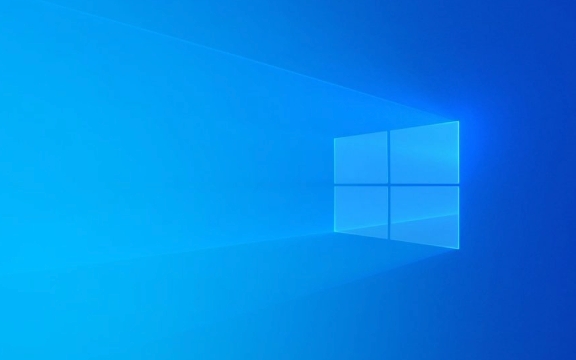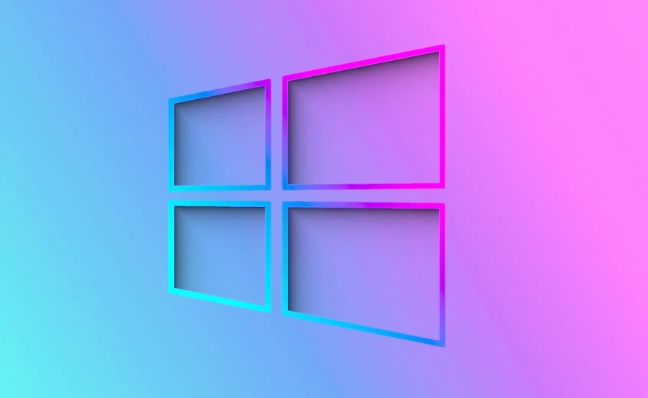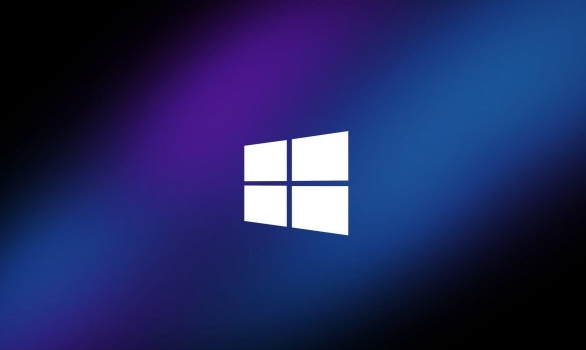How to enable efficiency mode for apps in Windows
Aug 03, 2025 pm 04:38 PMWindows does not have a direct “Efficiency Mode” switch, but similar effects can be achieved through a variety of built-in functions. 1. Use Task Manager: Press Ctrl Shift Esc to open, right-click the target application and select "Go to Details", then right-click the process to select "Set Priority" to "Lower than Normal" or "Low" to reduce CPU usage, and disable unnecessary power-on and self-start programs in the "Startup" tab. 2. Enable battery saver or power efficiency mode: Click the taskbar battery icon to turn on the battery saver, or automatically enable it through the Settings > System > Power & Battery settings to limit background activity, slow application synchronization and reduce visual effects. 3. Manage background application permissions: Go to "Settings > Apps > Installed Apps > Advanced Options", set "Background App Permissions" to "Never", or turn off the background operation globally in "Settings > System > Backend Apps". 4. Use Windows Sandbox or lightweight alternative applications: For high resource occupancy programs, you can use Windows Sandbox isolation in Pro/Enterprise versions, or use lightweight tools such as Notepad instead of heavy-duty IDEs, and give priority to web applications such as Office Online. 5. Use the PowerCfg tool for advanced optimization: Run command prompt as an administrator and execute powercfg /energy, generate energy consumption reports, identify high-energy-consuming applications or drivers and disable or replace them. By combining these methods, resource management and control of similar efficiency modes can be effectively achieved, and ultimately the purpose of improving performance and extending battery life.

Windows doesn't have a direct “Efficiency Mode” toggle for apps like macOS does, but it offers several built-in tools and settings that let you achieve similar results—reducing CPU, memory, and power usage for specific apps to improve system performance and battery life. Here's how you can effectively enable efficiency-like behavior for apps in Windows.

1. Use Task Manager to Limit Background App Activity
The easiest way to control how much system resources an app uses is through Task Manager , which allows you to set process priorities and restrict background activity.
Steps:

- Press
Ctrl Shift Escto open Task Manager . - Go to the Processes tab.
- Right-click on the app or background process you want to optimize.
- Choose Go to details (if not already in Details view).
- Right-click the process again and go to Set priority .
- Select Below Normal or Low to reduce its CPU priority, making it less likely to slow down other tasks.
?? Note: Be cautious with system processes. Only adjust priorities for apps you recognize.
Additionally:

- In Task Manager, under the Startup tab, disabled unnecessary apps from launching at startup to reduce background load.
2. Enable Battery Saver or Power Efficiency Mode
Windows includes power-saving modes that throttle app performance to save energy—especially useful on laptops.
To enable Battery Saver:
- Click the battery icon in the taskbar.
- Select Battery Saver to turn it on.
- Or go to Settings > System > Power & battery > Battery Saver and set it to turn on automatically when battery drops below a certain level.
When Battery Saver is on:
- Background apps are restricted.
- Mail and app syncing slows down.
- Visual effects are reduced.
This indirectly puts many apps into an efficiency mode by limiting their background activity.
3. Manage Background App Permissions
You can prevent apps from running in the background entirely, which is a form of efficiency mode.
Steps:
- Go to Settings > Apps > Installed apps (or Apps & features on older versions).
- Click on an app > Advanced options .
- Under Background app permissions , select Never .
Alternatively:
- Go to Settings > System > Background apps .
- Toggle off Let apps run in the background globally, or manage it app by app.
This stops apps from consuming CPU and network resources when not in use.
4. Use Windows Sandbox or Lean App Alternatives
For heavy or poorly optimized apps, consider running them in Windows Sandbox (available in Pro/Enterprise editions), which isolates them and limits system impact.
Alternatively:
- Replace resource-heavy apps with lighter versions (eg, use Notepad instead of full IDEs for quick edits).
- Use web versions of apps when possible (eg, Office Online instead of full Office suite).
5. Monitor and Optimize with PowerCfg (Advanced)
Windows includes a command-line tool called powercfg that can analyze energy usage and suggest improvements.
Example: Open Command Prompt as admin and run:
powercfg /energy
This generates an energy report (saved as an HTML file) highlighting apps or drivers using excessive power.
You can then use this info to disable or replace inherent apps.
While Windows doesn't label it “Efficiency Mode,” combining priority settings , background app controls , and power-saving modes give you fine-grained control over app efficiency. The key is identifying which apps consume the most resources (via Task Manager) and applying the right restrictions.
Basically, it's about smart resource management—no single switch, but plenty of effective tools.
The above is the detailed content of How to enable efficiency mode for apps in Windows. For more information, please follow other related articles on the PHP Chinese website!

Hot AI Tools

Undress AI Tool
Undress images for free

Undresser.AI Undress
AI-powered app for creating realistic nude photos

AI Clothes Remover
Online AI tool for removing clothes from photos.

Clothoff.io
AI clothes remover

Video Face Swap
Swap faces in any video effortlessly with our completely free AI face swap tool!

Hot Article

Hot Tools

Notepad++7.3.1
Easy-to-use and free code editor

SublimeText3 Chinese version
Chinese version, very easy to use

Zend Studio 13.0.1
Powerful PHP integrated development environment

Dreamweaver CS6
Visual web development tools

SublimeText3 Mac version
God-level code editing software (SublimeText3)
 How to reset the TCP/IP stack in Windows
Aug 02, 2025 pm 01:25 PM
How to reset the TCP/IP stack in Windows
Aug 02, 2025 pm 01:25 PM
ToresolvenetworkconnectivityissuesinWindows,resettheTCP/IPstackbyfirstopeningCommandPromptasAdministrator,thenrunningthecommandnetshintipreset,andfinallyrestartingyourcomputertoapplychanges;ifissuespersist,optionallyrunnetshwinsockresetandrebootagain
 What are the main pros and cons of Linux vs. Windows?
Aug 03, 2025 am 02:56 AM
What are the main pros and cons of Linux vs. Windows?
Aug 03, 2025 am 02:56 AM
Linux is suitable for old hardware, has high security and is customizable, but has weak software compatibility; Windows software is rich and easy to use, but has high resource utilization. 1. In terms of performance, Linux is lightweight and efficient, suitable for old devices; Windows has high hardware requirements. 2. In terms of software, Windows has wider compatibility, especially professional tools and games; Linux needs to use tools to run some software. 3. In terms of security, Linux permission management is stricter and updates are convenient; although Windows is protected, it is still vulnerable to attacks. 4. In terms of difficulty of use, the Linux learning curve is steep; Windows operation is intuitive. Choose according to requirements: choose Linux with performance and security, and choose Windows with compatibility and ease of use.
 How to troubleshoot a failed Windows installation
Aug 02, 2025 pm 12:53 PM
How to troubleshoot a failed Windows installation
Aug 02, 2025 pm 12:53 PM
VerifytheWindowsISOisfromMicrosoftandrecreatethebootableUSBusingtheMediaCreationToolorRufuswithcorrectsettings;2.Ensurehardwaremeetsrequirements,testRAMandstoragehealth,anddisconnectunnecessaryperipherals;3.ConfirmBIOS/UEFIsettingsmatchtheinstallatio
 How to enable Hyper-V in Windows
Aug 04, 2025 am 12:53 AM
How to enable Hyper-V in Windows
Aug 04, 2025 am 12:53 AM
Hyper-VcanbeenabledonWindowsPro,Enterprise,orEducationeditionsbymeetingsystemrequirementsincluding64-bitCPUwithSLAT,VMMonitorModeExtension,BIOS/UEFIvirtualizationenabled,andatleast4GBRAM.2.EnableHyper-VviaWindowsFeaturesbyopeningoptionalfeatures,chec
 How to solve touchpad not working issues on Windows?
Aug 05, 2025 am 09:21 AM
How to solve touchpad not working issues on Windows?
Aug 05, 2025 am 09:21 AM
Checkifthetouchpadisdisabledbyusingthefunctionkey(Fn F6/F9/F12),adedicatedtogglebutton,orensuringit’sturnedoninSettings>Devices>Touchpad,andunplugexternalmice.2.UpdateorreinstallthetouchpaddriverviaDeviceManagerbyselectingUpdatedriverorUninstal
 How to change screen resolution in Windows
Aug 02, 2025 pm 03:08 PM
How to change screen resolution in Windows
Aug 02, 2025 pm 03:08 PM
Right-clickthedesktopandselect"Displaysettings"toopenthedisplayoptions.2.Underthe"Display"section,clickthe"Displayresolution"dropdownandchoosearesolution,preferablytherecommendedoneforbestimagequality.3.Confirmthechanges
 how to fix 'the computer is not configured for a smart card' on a win pc
Aug 02, 2025 am 10:26 AM
how to fix 'the computer is not configured for a smart card' on a win pc
Aug 02, 2025 am 10:26 AM
EnsureSmartCard,SmartCardRemovalPolicy,andCertificatePropagationservicesarerunningandsettoAutomaticinservices.msc;2.InstallorupdatesmartcardreaderdriversviaDeviceManagerorthemanufacturer’swebsite,andinstallrequiredmiddlewarelikeActivClientorOpenSCifn
 How to fix 'The default gateway is not available' in Windows
Aug 02, 2025 am 06:54 AM
How to fix 'The default gateway is not available' in Windows
Aug 02, 2025 am 06:54 AM
RestartyourcomputerandroutertorefreshDHCPleasesandresetnetworkinterfaces.2.RuntheNetworktroubleshooterviaSettingstoautomaticallydetectandfixcommonissues.3.OpenCommandPromptasAdministratorandrunipconfig/release,ipconfig/renew,ipconfig/flushdns,netshwi






